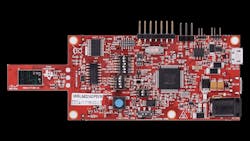Members can download this article in PDF format.
Millimeter-wave (mmWave) radar-sensor integrated circuits enable a variety of proximity-sensing applications. Today, 60-GHz radar sensors are replacing 24-GHz versions, with the higher-frequency devices offering improved resolution and accuracy while enabling more compact designs. The new versions also offer low-power architectures, making them suitable for use in a range of industrial applications.
Building and Factory Automation
Building and factory automation are key targets for the new generation of mmWave radar sensors, which can provide presence and motion detection to enhance comfort and convenience. Smart thermostats, for example, can employ radar sensors to provide efficient smart climate control by sensing room occupancy rates. mmWave radar can also assist with housekeeping and groundskeeping chores, enabling robotic lawn mowers and vacuum cleaners to complete their tasks safely and efficiently.
Sponsored Resources:
- Enable High-Accuracy Sensing in Emerging Applications
- How 60-GHz Radar Sensors Reduce False Detections for Sensing Applications
- Bringing Intelligence and Efficiency to Automated Doors and Gates with TI mmWave
In the factory, radar sensors are able to create a virtual safety net that allows for safe collaboration between humans and machines. In addition, they make it possible for automated guided vehicles (AGVs) and autonomous mobile robots (AMRs) to safely maneuver within a factory environment. In healthcare facilities, mmWave radar can provide fall detection and enable touchless door openers that help prevent the spread of germs and improve access for the disabled.
Automated Doors and Gates
Automated door applications extend well beyond healthcare. The automated door and gate market divides into roughly three segments: interior doors, which require ranges from less than 50 cm to 0.5 m; commercial building entrances, which require ranges of 4 m or more; and outdoor industrial gates, which require ranges of 10 m or more. Radar sensors can operate over ranges from 5 cm to more than 100 m, easily meeting the requirements of all three segments.
Industrial gates operate outdoors with varying light, precipitation, and temperature conditions. mmWave radar sensors are well-equipped to capture the position and velocity of an object in a variety of environmental conditions to determine the optimum time to open a gate and how long it should remain open.
Building entryways have several sensor requirements: presence detection to ensure doors don’t close when people are in the doorway, for example, as well as image classification to ensure animals don’t enter. These doors generally require fields of view of ±70 degrees.
Finally, the interior segment includes doors that people can open with a hand gesture. They require sensors with very short detection ranges—less than 50 cm—and fields of view no larger than ±45 degrees to minimize false positive detections and unnecessary door openings.
A mmWave radar sensor excels with such an application. It can minimize false detections by ensuring that the object initiating the opening exhibits the major and minor motions of a human hand and isn’t an inanimate object inadvertently left near the sensor’s aperture.
Minimizing False Detections
False detections can occur across all automated door and gate market segments, as well as other applications involving proximity sensing. False positives are inconvenient at best and can foster “alarm fatigue” among the humans charged with responding.
Furthermore, many sensors have energy-saving sleep modes, and frequent false detections that wake them up can prematurely drain batteries. False negatives may cause an automatic door to fail to open or, more seriously, a security system to fail to identify an intruder.
In addition to radar, passive-infrared (PIR) and vision sensors can serve in presence-detection applications. However, PIR sensors have low sensitivity to motion, can perform poorly at high temperatures, and are unable to reliably distinguish between humans and animals. They can perform well in an office environment with a controlled climate and where the presence of animals is unlikely, but they’re less effective in outdoor settings.
Vision sensors have their own issues. For example, they may compromise privacy and can perform poorly in conditions involving shadows or bright light.
An effective alternative that minimizes false detections is a mmWave radar sensor such as Texas Instruments’ IWRL6432, an integrated single-chip device that operates in the 57- to 63.9-GHz band. In addition to an RF/analog subsystem, front-end controller subsystem, and hardware accelerator, the IWRL6432 includes an application subsystem with a user-programmable Arm Cortex-M4 that allows for customization.
A companion product, the IWRL6432AOP, incorporates an antenna-on-package, which eliminates engineers’ need to design their own antennas and specify expensive printed-circuit-board materials to minimize antenna losses. Both sensors feature low-power operation, enabling long operating times between charging for battery-operated equipment.
The IWRL6432 and IWRL6432AOP can both identify micromovements common to humans, such as breathing and fidgeting, thereby minimizing false detections. Presented with the scene depicted by a doorbell camera on the right in Figure 1, for example, a radar sensor is able to distinguish between the human (represented by the green circle in the radar output image on the left) and a potted plant (yellow circle).
In addition, engineers applying the IWRL6432 and IWRL6432AOP can leverage their onboard processing capability to apply multiple filtering methods to further reduce false detections. This includes a range filter that ignores objects appearing very close to the sensor, such as a bird suddenly alighting on a railing close to a doorbell sensor. Engineers can also use the devices to extract a Doppler motion signature from a target to classify it as a human, plant, or animal.
TI offers evaluation modules to help you get started on your all aspects of your designs, including false detection avoidance. Figure 2 shows the IWRL6432AOPEVM evaluation module with the IWRL6432AOP antenna-on-package device mounted on the left.
Conclusion
mmWave radar sensors are enabling a variety of sensing applications requiring strict power budgets. Devices such as the 60-GHz IWRL6432 and IWRL6432AOP combine high sensing accuracy and low-power architectures with onboard intelligence to minimize false detections. And TI’s evaluation modules can help you get started on your mmWave radar hardware and software designs, helping you address aspects ranging from maximizing accuracy and efficiency to minimizing false detections.
Sponsored Resources:
- Enable High-Accuracy Sensing in Emerging Applications
- How 60-GHz Radar Sensors Reduce False Detections for Sensing Applications
- Bringing Intelligence and Efficiency to Automated Doors and Gates with TI mmWave


